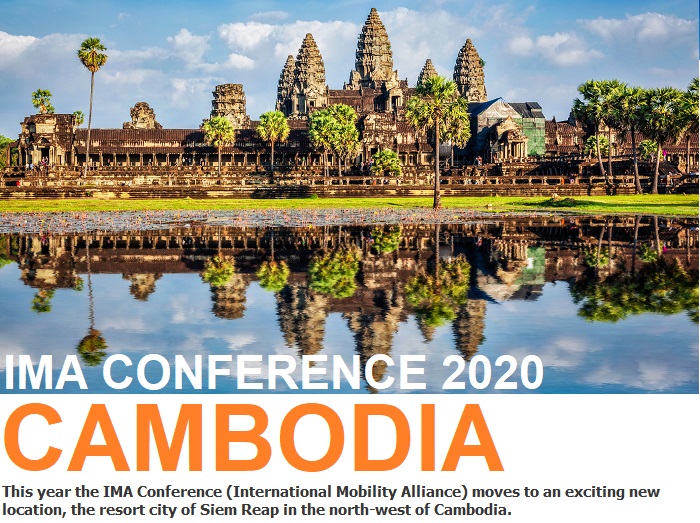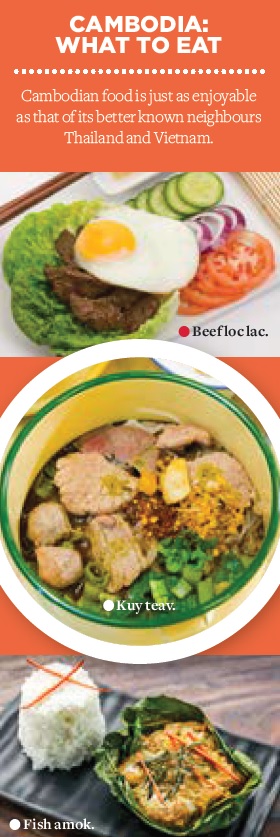This year the IMA Conference (International Mobility Alliance) moves to an exciting new location, the resort city of Siem Reap in the north-west of Cambodia. For many this will be their first time in Cambodia, so apart from the conference, what is there to do and see and what do you need to look out for?

Back in the 1960s and 70s Cambodia was one of the most volatile countries on earth, ravaged by war and the brutal regime run by Marxist dictator Pol Pot that resulted in over two million deaths. Thankfully those dark days are long gone, and Cambodia has become an all-year tourist destination for travellers from around the world.
Nevertheless, Cambodia is still, by western standards, a poor country so it pays to be careful and not to invite crime by flaunting expensive jewellery, iPhones or designer handbags while taking in the local scenery. Reassuringly though, Siem Reap is considered to be one of the safest places in the country, so no need to be paranoid.
What to see
Just a few miles from Siem Reap lie the ruins of the ancient city of Angkor, the capital of the Khmer kingdom from the 9th to the 15th centuries. The main temple, Angkor Wat, is said to be the world’s largest religious building and is just one of more than 1,000 temples, in varying states of repair, on the famous UNESCO World Heritage Site. Visiting Angkor is an unforgettable experience and one you really do not want to miss.
If you’re interested in learning more about Cambodia’s more recent past, head 25 kilometres north to the Cambodian Landmine Museum. The museum holds examples of some of the five million landmines still thought to be buried in the countryside; left by Khmer Rouge forces and others during the Pol Pot era. The museum tells the story of how the mines have changed the lives and culture of people in the area through the lens of Aki Ra, the Khmer man who discovered and made safe many of the mines now on display. The Landmine Museum is open from 7:30 – 17:30 every day of the year.
 What to eat
What to eat
Cambodian food may not be as renowned as its neighbours Thailand and Vietnam, but is nonetheless just as delightful. Seafood is a popular choice for many and Cambodia’s signature dish, Fish amok, a sort of creamy fish curry, is well worth a try.
If fish isn’t really your thing try the traditional Cambodian breakfast, Kuy teav, a noodle soup made from pork or beef bones and rice vermicelli and topped with bean sprouts, aromatic herbs, garlic and green onions.
Another traditional dish is Beef loc lac, which comprises stir-fried strips of beef served with lettuce, tomatoes, cucumber and raw onions. Often, a fried egg is placed on top. The dish comes with a dipping sauce made from lime juice and pepper - yummy!
What to drink
As with all tropical countries, it’s important to keep well hydrated, so carrying bottled water is essential when away from your hotel.
As you would expect in a hot country, drinking beer is popular in Cambodia, the two most popular being the local Anchor and Angkor brands. There are of course plenty of imported beers to choose from if you really don’t want to go local.
Local wines are also available but may not be to everyone’s taste, but they are usually cheap, strong, and worth giving a try if you want something different. Moderation is recommended! Plenty of soft drinks, iced teas and coffees are also in plentiful supply.
Health
Check that your medical insurance is up to date and that it covers travel to Cambodia. Do not drink tap water and avoid taking ice in drinks, especially in local restaurants and bars.
Well before leaving, take advice from your doctor about what injections are recommended for your trip and also if malaria tablets are considered necessary. Although the risk of catching malaria in Siem Reap is fairly low, the local ‘tiger mosquitoes’ pack quite a punch, so at the very least make sure you bring plenty of insect repellent.
Travel documents
Make sure your passport is in date and does not expire for at least six months after your departure from Cambodia. You will also need a tourist Visa which can be bought at the airport on arrival for around USD $30. To avoid any long queues at the airport you may prefer to apply online before departure. Contact the Cambodian Embassy in your country of residence to check on Visa requirements for your trip.
Cambodia is an exotic, fascinating country that lives long in the memories of those who go there. Last year over 200 people attended the IMA Conference in Bangkok and with this year’s change of venue the organisers are hoping for even more. Click here for more information.
Photos: Angkor Wat, What to eat in Cambodia.